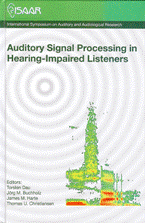The effects of noise reduction on cognitive effort in normal-hearing and hearing-impaired listeners
Abstract
A common complaint of hearing-impaired listeners is dif culty understanding speech in the presence of noise. Digital hearing aids have opened the door to complex signal processing algorithms that attempt to improve the quality, ease of listening, and/or intelligibility of speech in noisy environments. In reality, however, hearing aid users show no intelligibility improvements from single-microphone noise reduction (NR) algorithms, even though they sometimes report that speech sounds easier to understand. A possible explanation for this dichotomy is that NR algorithms replace a function that the human auditory system would otherwise perform. This redundancy means that there is no improvement in intelligibility, but a reduction in listening effort, since fewer cognitive resources would be necessary. We investigated this hypothesis using a dual-task paradigm with normal-hearing and hearing-impaired listeners. They were asked to repeat sentences or words presented in noise while performing either a memory or a reaction-time task. Our results showed that degrading speech by reducing the signal-to-noise ratio increased demand for cognitive resources, demonstrated as a drop in performance in the cognitive task. Use of a NR algorithm mitigated some of the deleterious effects of noise by reducing cognitive effort and improving performance in the competing task.
References
Broadbent, D. E. (1958). “Perception and Communication,” Pergamon Press, London.
Ephraim, Y., and Malah, D. (1984). “Speech Enhancement Using a Minimum Mean-Square Error Short-Time Spectral Amplitude Estimator,” IEEE Transactions on Acoustics, Speech and Signal Processing 32, 1109-1121.
Ephraim, Y., and Malah, D. (1985). “Speech Enhancement Using a Minimum Mean- Square Error Log-Spectral Amplitude Estimator,” IEEE Transactions on Acoustics Speech and Signal Processing 33, 443-445.
IEEE (1969). “IEEE Recommended Practice for Speech Quality Measurements,” IEEE Transactions on Audio and Electroacoustics Au17, 225-246.
Kahneman, D. (1973). “Attention and Effort,” Prentice-Hall, New Jersey.
Lunner, T. (2003). “Cognitive function in relation to hearing aid use,” Intern. J. of Audiol. 42, S49-S58.
Pichora-Fuller, M. K., Schneider, B. A., and Daneman, M. (1995). “How Young and Old Adults Listen to and Remember Speech in Noise,” J. Acoust. Soc. of Am. 97, 593-608.
Additional Files
Published
How to Cite
Issue
Section
License
Authors who publish with this journal agree to the following terms:
a. Authors retain copyright* and grant the journal right of first publication with the work simultaneously licensed under a Creative Commons Attribution License that allows others to share the work with an acknowledgement of the work's authorship and initial publication in this journal.
b. Authors are able to enter into separate, additional contractual arrangements for the non-exclusive distribution of the journal's published version of the work (e.g., post it to an institutional repository or publish it in a book), with an acknowledgement of its initial publication in this journal.
c. Authors are permitted and encouraged to post their work online (e.g., in institutional repositories or on their website) prior to and during the submission process, as it can lead to productive exchanges, as well as earlier and greater citation of published work (See The Effect of Open Access).
*From the 2017 issue onward. The Danavox Jubilee Foundation owns the copyright of all articles published in the 1969-2015 issues. However, authors are still allowed to share the work with an acknowledgement of the work's authorship and initial publication in this journal.


